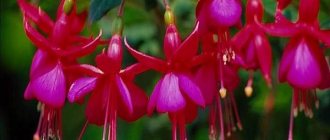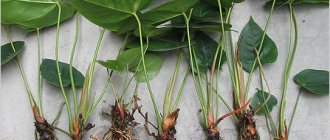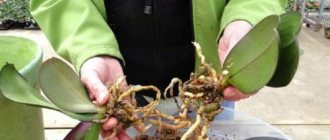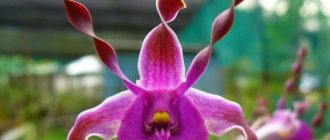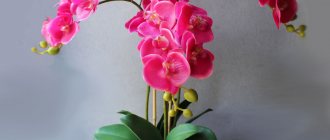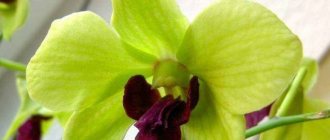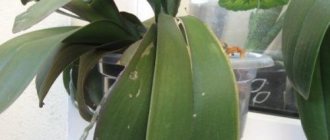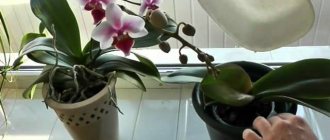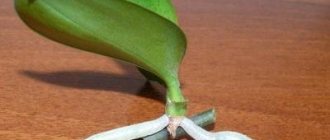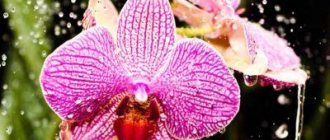Difference in Definitions
In order not to make a mistake in choosing the right filling for a flower pot, you should first understand the difference between soil, substrate and soil :
- Soil is a more universal name, as it denotes both a natural mineral component of the earth and one manually created for gardening purposes. The composition is rich in organic components.
- Soil is a natural component of the earth that contains deposits of plant and animal organisms. Natural environment for the growth of most representatives of the plant world.
- Substrate is an artificially created mixture for growing vegetation in it; it does not necessarily contain soil. From Latin it is translated as sublayer, litter. The main function is to feed the plant with nutrients and oxygen.
The concepts are often confused, and a flower shop may sell you a substrate mixed with earth.
Ordinary soil is absolutely not suitable for growing orchids; they simply do not need soil.
Peculiarities
Soil for orchids should not contain soil. Typically a mixture consists of several components , each of which serves its purpose.
Also, ingredients not only of natural origin, but also artificial ones, began to be added to the substrate for growing a flower. This is done to improve the quality of filling and living conditions of the plant.
The main requirement for the substrate is to prevent rotting of the root system by ensuring free access to oxygen. Some types of orchids are quite light-loving, so the universal substrate should not interfere with the free entry of light rays.
The importance of making the right choice
Important criteria for a properly selected substrate for orchids: quality and composition . Compliance with the requirements ensures harmonious development, growth and systematic flowering.
Today, every flower shop offers a ready-made mixture developed specifically for this type of plant. But not every finished product can be absolutely beneficial for your flower, so be careful when choosing it.
Nuances to pay attention to:
- The bark pieces are solid, strong, without visible damage. Size – up to 3 cm each. It is important that they do not crumble in your hands.
- The pieces of charcoal should not be larger than 2 cm and should not crumble.
- Moss should not be wet. A quality component – well dried and disinfected.
- If the substrate looks like a hard earthen lump, such a product is considered to be of poor quality.
- There should be no soil in the substrate, as it will accumulate moisture, harden and deprive the mixture of its ability to transmit oxygen.
- The substrate should be free of dust and moldy pieces.
Why is store-bought substrate bad?
Recently, the niche of substrates for orchids has been filled in the market. Products from imported and Russian manufacturers have appeared on the shelves of garden centers and flower shops. The main components of such substrates are moss and tree bark. There are also expensive mixtures with additional, rare ingredients.
However, even products of patented well-known brands do not always have the appropriate quality . Attract customers with beautiful, bright packaging. And inside there is a large amount of peat and soil dust, and there is catastrophically little bark. This ratio negatively affects the growth and development of the orchid.
If, despite all the warnings, you decide to go with a purchased substrate, read the tips for choosing it.
Photo
Next in the photo you can see the soil mixture for the plant:
What should be the required soil composition?
In order for the orchid to live on your windowsill as long as possible, it is important to choose the correct filling for the flowerpot. For epiphytic orchids (in the wild growing on the bark of trees), the following compositions are recommended :
- 90% pine bark, 5% charcoal, 5% dried and disinfected moss.
- 70% bark, 10% peat, 10% perlite, 10% redwood bark.
- 50% bark, 20% foam pieces, 15% expanded clay, 10% peat, 5% coal.
For terrestrial varieties of orchids, such mixtures are suitable:
- 40% peat, 20% dry oak leaves, 20% pine bark, 20% expanded clay.
- 35% peat, 35% clay sand, 15% perlite, %% pine bark.
What is better not to add to the composition?
Expanded clay is quite often used in preparing a good composition for growing orchids. This product has certain advantages - it retains moisture well.
Among the negative nuances, this component is characterized by the property of accumulating salts contained in water for irrigation. In the future, this is fraught with salinization of the entire soil, which will lead to a loss of the ability to retain vital moisture.
When expanded clay dries, it begins to draw moisture from the roots of the plant . Therefore, if this ingredient is still present in the composition, you should carefully monitor the sufficient amount of watering, and also periodically change the mixture. It is strictly forbidden to add soil to the substrate for orchids.
Such a rash step will lead to withering of the plant and drying out of the root system. If the flower shop sold a mixture with soil, it is better to sift it.
What does soil for orchids consist of?
Successful growing of plants directly depends on the quality of the soil. Soils for home floriculture must meet certain requirements:
- have the ability to retain water for the root system;
- do not retain moisture in the pot for more than four days;
- not be compressed, allow air to pass through well.
Following these classic rules allows you to have beautiful, healthy flowers of all types all year round. The roots of representatives of the orchid family have a unique ability to store moisture, like an earthen lump in a pot, and then release it to the plant. This property is due to the presence of a layer of velamen on them, which has a structure similar to a sponge, and should not be kept wet for a long time - otherwise it will rot. The velamen covering replaces soil for orchids, and this is their main difference from all other types of indoor flowers.
The root system of orchids transfers the accumulated liquid to the plant, remaining dry and able to breathe air, that is, the substrate must dry out as quickly as possible. This is the main condition that the finished soil must meet.
Soil components
Stores now offer a wide range of ready-made soil mixtures for growing orchids, but it is not always possible to choose soil for a specific species. It is easy to prepare the necessary substrate with your own hands; the choice of components should be determined not by the nutritional qualities of the components, but by how permeable the finished mass will be to air, moisture and light. Soil consists of several ingredients of both natural and man-made origin.
Soil components:
- wood, pine bark;
- sphagnum moss;
- fern roots;
- coal;
- expanded clay;
- polystyrene;
- coconut fiber;
- peat;
- perlite – rock;
- vermiculite – mineral;
- Pine cones.
Each material plays its role. This determines its share in the total volume of the substrate so that the soil mixture is properly structured and meets the necessary requirements.
tree bark
The main component of soil for orchids is tree bark. It experiences significant stress from moisture and growing roots. Its condition directly affects the quality of the soil mixture.
The best option is pine; you can also use other conifers. This material is offered by flower shops, but it is easy to prepare it yourself. Collection is carried out only from dead trees: sawn logs, dead wood or dead wood. The pieces must be taken strong, without mold, signs of rot and massive damage by insects. Purchased or collected bark must be processed as follows:
- boil in water for an hour: to destroy eggs and insect larvae and cleanse excess resins;
- cut into thick pieces measuring 2x2 cm;
- dry in the oven at 100 degrees.
The material is ready to be sent to a flower pot. To reduce the acidity of the soil, you can add a pinch of dolomite flour.
Sphagnum moss and fern roots
Swamp sphagnum moss has a number of properties that create comfortable conditions for the growth of orchids, namely:
- imparts looseness to the soil;
- retains moisture without compacting the soil;
- absorbs harmful salts;
- prevents rotting.
It can be purchased ready-made, pre-dried and disinfected. When preparing yourself, the collected raw materials must be sorted, washed, poured with boiling water and, after being squeezed out, dried well. The best time to collect is late autumn.
Sphagnum is an ambulance for orchids that die from rotting or drying out roots.
Fern rhizomes have properties similar to moss. Before adding to the soil, they are cut into small pieces and subjected to the processing described above.
Technical materials
Flower growers widely use technical materials to structure the soil. These are expanded clay, polystyrene, polystyrene foam and foam rubber. Expanded clay drainage is indispensable when growing orchids; its main advantage is its high hygroscopicity. Charcoal has a similar property, which is also used as a disinfectant and absorbent. It is included in the soil in pieces of at least two centimeters.
Fragments of synthetic materials - polystyrene, polystyrene foam and foam rubber - show their properties very well in the composition of soil for orchids. Their presence significantly reduces the risk of caking of the soil mixture and increases its breathability; moreover, they do not emit harmful substances and have a long service life.
Other soil components
Peat, pine cones, coconut fibers, perlite rock and the mineral vermiculite can be added to the orchid substrate. All these components increase the looseness of the soil mixture, prevent it from caking and increase air permeability.
In addition, peat and vermiculite can protect plants from mold, fungal infections, harmful insects and retain moisture in the soil. When using peat, it is necessary to take into account its high acidity; dolomite flour is added to reduce it. All species of the orchid family are epiphytes, so the classic version of soil for indoor flowers is not suitable for them. The substrate for orchids should consist mainly of whole pieces of pine bark up to three centimeters in size, with the addition of sphagnum and expanded clay.
Important! If there are midges in the orchid's soil, you need to change the contents of the pot!
The composition may include other additional components that increase air permeability and looseness of the soil. The durability of the constituent materials and their sizes affect the duration of use of the prepared mixture.
What is each component used for?
Each component for the substrate is important and has specific functions:
- Moss . Widely used for preparing the composition. It is hygroscopic and absorbs moisture vapor well. Contains many useful microelements - more than in tree bark. Disinfected moss prevents the development of pathogenic bacteria.
- Bark. The most popular component for preparing a good substrate. In percentage terms, it predominates in the composition.
It has all the necessary characteristics - it evenly distributes the moisture received during the irrigation process and allows air to pass through perfectly.To protect the orchid from insects and resin, it is better to heat-treat the bark before use. This recommendation applies to cases where the substrate is prepared independently.
- Drainage . Used to provide air access, drainage of excess liquid, as well as stable fixation of the root system. The most commonly used are expanded clay, pieces of polystyrene foam, small crushed stone, and gravel. This layer is placed at the bottom of the pot.
- Earth .
For most varieties of orchids, this component is superfluous. Small amounts can be added to the composition for growing terrestrial plant species. In the case of homemade preparation, it is recommended to calcine the earth at high temperatures in the oven for 20 minutes. Thanks to this manipulation, pathogenic bacteria will not be able to harm your flower. - Coal .
Charcoal is added to almost every substrate, but in a proportion of no more than 5% of the total mass. Improves air and water permeability. Keeps the soil from becoming waterlogged and prevents it from oxidizing. It also acts as an antiseptic and prevents putrefactive processes from developing. - Minerals. They are considered a nutritional supplement and compensate for the lack of useful elements. They prevent salt from accumulating and maintain the required level of acidity.
Most often, the orchid is fed with the following minerals:- potassium;
phosphorus;
- nitrogen;
- boron;
- iron;
- magnesium;
- sulfur.
In minimal quantities:
- manganese;
- zinc;
- chlorine;
- silicium.
In what homemade soil can you plant an orchid at home?
By preparing a mixture for phalaenopsis with your own hands, you can save a lot. The process as a whole is not very labor intensive, but the problem usually arises with finding ingredients.
Advice: choose the right fraction of materials. The older the orchid, the thicker its roots, which means it needs larger pieces, and vice versa.
Standard composition
Homemade substrate contains basically the same ingredients as store-bought substrate. So, it may include:
- bark (pine, oak or spruce);
- sphagnum;
- charcoal (natural, not briquettes);
- high peat;
- fern roots.
All components must be prepared in advance and stored separately. Mix them immediately before planting phalaenopsis.
Comparison with purchased
It is difficult to say with absolute certainty which soil is better - store-bought or home-made.
In the first case, the necessary materials are usually present in average proportions. All of them undergo sterilization. However, such mixtures do not take into account the individual conditions existing in a particular apartment. This means that they will have to be improved on their own.
Self-prepared soil is often cheaper, and sometimes, if you can collect the components yourself, it’s completely free.
However, it is industrially created substrates that inexperienced phalaenopsis collectors should choose. This approach is safer than trying to make soil without proper experience.
Advantages and disadvantages
Homemade substrate is usually of higher quality, provided that the raw materials have been carefully selected and sterilized.
By preparing the soil, you can choose the optimal proportion of components that meets the humidity of your home and the requirements of the phalaenopsis variety being grown.
On the other hand, not all components of the soil for orchids can be found in our country outside the store. Thus, you still have to buy some things.
Where to get components
The most labor-intensive process is collecting the bark. But if there is a sawmill in your city, then go there. Typically, the ingredient in question is sent to waste at such a facility, and therefore may be given away for nothing.
It’s possible to get bark from the forest. It is better not to strip it from a living tree - look for fallen trunks. With the latter it can be removed quite easily.
Peat is easier to buy - its price is low, and the quality is quite acceptable.
Sphagnum moss in our latitudes mainly grows in swamps or damp lowlands. It is permissible to collect it at any time of the year. For our purposes, only living top branches are suitable. Cut them carefully with a knife. The best moss is found near trees.
The collected raw materials must be sorted out - throw away all specks, pine needles, and browned fragments. Dry the rest in a dark place, hanging in bunches. In the future, store in plastic bags.
Tip: the fact that the sphagnum is ready is indicated by its strong discoloration.
Look for humus or deciduous soil in the country house or in the forest. It is better to collect them in the spring, after the snow has melted.
What is suitable to replace natural materials?
In addition to organic components, the composition for orchids may also contain inorganic ones:
- vermiculite (mica-based mineral) – absorbs moisture and has a draining effect;
- expanded clay – retains moisture, provides stability to the root system;
- perlite (also included in cat litter) – perfectly absorbs excess moisture.
There are gardeners who use crushed bricks as drainage. This is not recommended, as over time it turns into dust and interferes with the normal circulation of air and water.
What to choose: ready-made substrate or homemade one?
It is difficult to compare store-bought soil and homemade soil. The finished product contains the ingredients in the correct proportions, is processed and is ready to eat.
But you can’t always be sure of its quality. You will be 100% confident in the composition you prepare yourself , but it is not always possible to obtain every component.
The best recommendation would be to add your own components to a product purchased in a store, which will significantly improve and enrich it.
Pros of home soil:
- cheapness;
- high quality;
- individual selection of components suitable specifically for your type of orchid;
- exact observance of proportions.
Minuses:
- sometimes components are difficult to obtain;
- Preparation and disinfection of pine bark is a labor-intensive process.
What should you buy?
Unfortunately, not all substrate ingredients can be found in the natural environment. Inorganic components should be purchased at the store.
Expanded clay . This building material has proven itself well as drainage. Expanded clay is a natural material obtained by firing clay. The substance is light, porous, inexpensive, environmentally friendly. Granule fractions are different, in this case they are chosen based on the size of the roots.- Perlite, vermiculite, gravel are environmentally friendly materials necessary for draining and loosening the soil. Sold in construction departments.
- Styrofoam . It is considered an unconventional component of the soil mixture. However, at later times it becomes more and more in demand. Polystyrene foam is used as a leavening agent and also as drainage. The material is chemically inert, lightweight, non-toxic, provides high looseness and water permeability.
- Coconut chips, fiber . Components are sold in the form of blocks in specialized stores. They are separately packaged and pre-disinfected.
How should you choose a substrate in the store?
When choosing purchased soil, follow these rules::
- pieces of bark - whole, dense, without defects, up to 3 cm each;
- the pieces do not crumble in your hands under mechanical stress;
- charcoal is strong, up to 2 cm each;
- dry moss;
- absence of dust and mold;
- Before purchasing, it is important to read the label on the package, which indicates the proportional composition, as well as information that it is suitable specifically for your type of orchid.
What are the ready-made products for growing flowers?
Popular brands of soil used by gardeners:
- Orchiata (composed of New Zealand pine bark);
- ZeoFlora (soil contains minerals with zeolite);
- Compo Sana (the substrate has high moisture resistance and air permeability);
- EffectBio (produces a wide range of mixtures and soil enrichers);
- Fusco (all substrates contain only natural ingredients);
- Seramis (contains clay granules).
When choosing, you should remember that the soil has a different composition depending on the variety and age of the plant.
An overview of different ready-made substrates for orchids can be found in this video:
Is it possible to prepare the soil yourself?
Flower growers who are just starting to grow orchids prefer to purchase ready-made substrate in stores. But experienced flower growers prepare the soil mixture on their own. They believe that such soil is considered to be of higher quality. Preparing such a substrate is not at all difficult.
In addition, it has a number of other advantages:
- costs minimal cost;
- the grower is completely confident in the quality of the components;
- the ability to select components in accordance with the varieties of orchids;
- The recipe is as simple as possible, the mixture is prepared quickly.
Important! Do not forget that the soil needs to be replaced every 2-3 years.
How to make the mixture yourself?
For home cooking you will need:
- pine or other coniferous tree bark (5 parts);
- sphagnum moss (3 parts);
- coarse sand (1 part);
- peat or fern roots (1 part).
Even if you don’t have some of the components on hand, you can make a simple mixture that is suitable for growing orchids in greenhouses :
- 5 parts bark;
- 1 part crushed charcoal.
This video explains how to make a substrate for orchids:
Soil preparation
Simple soil is not capable of creating a complete environment for the fragile aerial roots of an orchid to ensure development and growth. For this reason, experienced gardeners use a special mixture called substrate to grow exotic plants.
The composition of the substrate and the proportions of its components may depend on the varieties of orchids grown and on their requirements for the presence of certain ingredients. Universal mixtures suitable for growing most known hybrids are also found in modern gardening stores. The main ingredients of such mixtures are usually:
- peat;
- sphagnum;
- chopped tree bark;
- vermiculite;
- perlite;
- coal;
- humus;
- clean and coarse sand.
Sometimes quite unexpected components are found in the composition of universal substrates. These include fern roots, coconut and cork fiber, pine cones, fragments of foam plastic and volcanic rocks.
Substrate requirements
A number of requirements for the soil mixture (substrate) for orchids include such criteria as:
- environmental friendliness;
- water permeability;
- factionalism;
- breathability;
- ease.
In addition, the substrate, which is suitable for exotic plants, has a loose structure and the ability to retain nutrients. Specialized mixtures intended specifically for growing orchids do not contain small fragments or dust-like particles, which lead to caking and compaction of the substrate over time.
When growing orchids, it should be taken into account that during the flowering period they consume a large amount of nutrients from the substrate. For this reason, it is recommended to replant plants into a new substrate once every 2-3 years, replacing the depleted mixture with it.
For transplantation, it is advisable to use a substrate with the same composition to which the exotic plant has become accustomed during its existence. Before replanting the plant, the mixture is laid in layers. First, a layer of drainage is laid on the bottom of the pot, then the substrate is filled up to half the container, after which the drainage is laid again and the filling is completed with another layer of substrate.
Is it possible to plant a houseplant in ordinary soil?
For normal functioning, the orchid root system requires constant access to light and oxygen. Accordingly, the substrate must contain light components, but the earth will simply kill the roots under its pressure.
The dense composition of the soil will disrupt the drainage process , and the water will stagnate. An orchid simply cannot grow and develop in such unnatural conditions. The usual habitat for an exotic flower is the surface of a tree, and not dense soil.
Containers for orchids
photo from site zinoti.lt
The normal growth and development of an orchid also depends on the pot in which it grows. You need to choose it taking into account the size of the plant and its root system, and the characteristics of its growth in nature.
The root system of orchids prefers to be in close quarters, so the flower does not need a free pot. When it becomes too crowded, transplant it into a container that is only a few centimeters wider in diameter than the previous one.
Orchid pots should have as many holes as possible to allow excess moisture to escape. It would be good if there were drainage holes not only at the bottom, but also in the side walls.
Most orchids require transparent containers for their roots to participate in the process of photosynthesis; only a few species can grow in pots that are impenetrable to light. And, of course, the container must be stable, so often a flower in a transparent pot is placed in a heavy pot. In this case, the distance between the walls of the containers must be at least 2 cm.
Pot material comes in a variety of varieties and each has its own advantages and disadvantages.
Glass pot for orchids
photo from thegadgetflow.com
In a glass pot, the plant's roots receive enough light, but there are no drainage holes. Therefore, it is necessary to grow an orchid in glass on a large layer of drainage, constantly monitoring watering.
Plastic pot
photo from cropsupplies.co.za
You can easily make as many holes as you need in a clear plastic pot, but it is very light and unstable. Placing it in a planter will solve this problem.
Ceramic pot
photo from reddit.com
Ceramic pots for orchids can be of fancy shapes with elegant holes on the walls and drainage holes in the bottom. They are stable, so large, fast-growing orchids are grown in them. However, their roots often grow to the surface of the pot.
To prevent this from happening, choose containers with icing inside. Ceramics retain temperature for a long time, so to avoid overheating of the roots, give preference to a light color.
Baskets for growing orchids
A metal, wooden or bamboo basket is a universal and most common container for orchids. It is easy to create an optimal water-air regime, and the plants feel free, almost like in nature.
The disadvantage of wooden or bamboo baskets is that plant roots often grow to the rods. When transplanted they break off. Therefore, the best option is a mesh metal planter.
- Proper transplantation of orchids: putting everything on the shelves
Is it time to replant your orchid? Use our tips to do it right.
The choice of substrate and pot for orchids is an important and crucial moment that will affect the entire process of growing this spectacular plant. Properly selected, they will help it bloom long and profusely.
Possible errors and solutions to problems
Incorrectly selected or prepared soil will harm the roots of your plant. Due to the dense substrate, the orchid may rot. A dying flower can be revived by transplanting it into a new substrate.
Choosing the wrong soil for a flower often poses many problems.:
- Sometimes a white coating appears on the orchid substrate, which resembles fluffy yarn. This is a mold caused by wood rotting processes. This happens when the substrate sticks too tightly to the root system.
- Shaggy mold on the orchid substrate can eventually spread to the flower itself, covering not only its roots, but also its stem.
The ideal environment for fungus is a high level of humidity. If the crop is watered too often and the substrate does not have time to dry out, this problem arises. - If the roots and substrate of the orchid are covered with a silvery coating, then there is nothing wrong with that. This is the normal state of a healthy flower when the soil in its pots has dried out. It is enough to ensure normal watering, and the problem will disappear over time.
For a luxurious, healthy plant and constant flowering of the orchid, you should approach the issue of choosing soil consciously. Without the right substrate, serious problems can arise, including the death of the flower. Care when purchasing or making soil will bring wonderful fruits of floriculture.
Recovery
If the orchid begins to fade, the leaves turn yellow, the plant sheds its inflorescences, then add fertilizer, use biofungicides for fungus or insecticides for insects. If all resuscitation efforts do not help, then the flower is planted on perlite. The material is clean. The orchid is given the opportunity to recover.
We recommend: How do we take cuttings of roses in perlite?
The flower is removed from the ground or substrate. The roots are washed in a solution of potassium permanganate or hydrogen peroxide and freed from soil. It is recommended to treat it with Fitosporin. Place the bush on clean perlite. The old soil is discarded. If expanded clay or other substrate was used, it can be washed, kept in an antiseptic, and reused.
- The mineral pellets are saturated with filtered, warm water. The optimal temperature is 37 0C. Allow the substrate to soak for 24 hours. Excess liquid goes into the pots.
- Make a hole and place a bush in it. The orchid's heel and aerial roots remain on top of the soil.
- Place the flower in perlite, in a warm room where the temperature is maintained at 250C and humidity up to 70%.
- Organize additional lighting using a phytolamp. Lighting should be diffused. It is not recommended to change the place for the orchid. It takes her a long time to get used to the new microclimate.
- There is no need to cover the bush with a dome or film. Covering material is used if it is impossible to create high humidity in the room. The plant is ventilated daily.
Water the plant when the substrate takes up liquid from the pots. You can use wick irrigation technology. In this case, the pots are filled with a nutrient solution. A string and wick are lowered from the mineral filler to the solution. You can make 3-4 sections to better saturate the perlite.
In the future, the orchid can be transplanted onto the ground, bark or other substrate. It is necessary to wait until it produces new root shoots and leaves.


